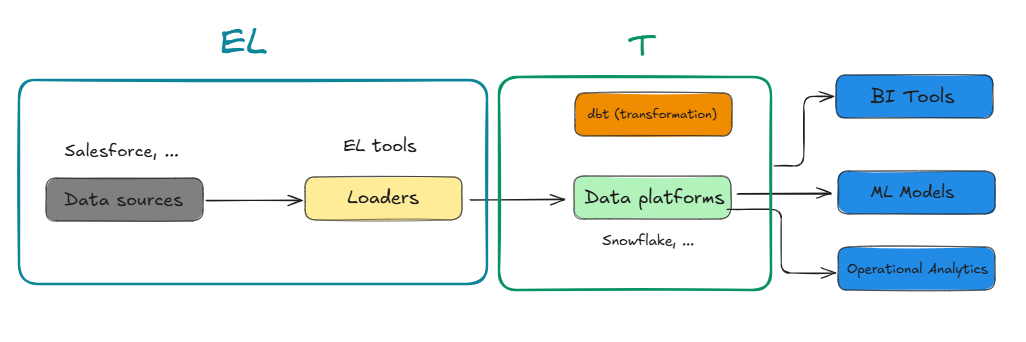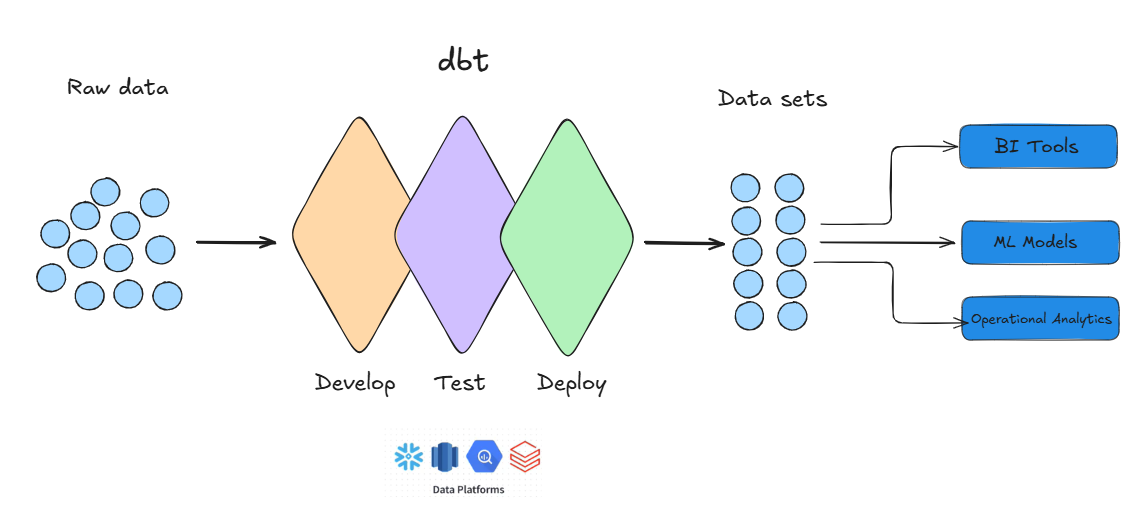If you're new to dbt (Data Build Tool), think of it as the link between raw data and actionable insights. dbt transforms messy, unstructured data into clean, analysis-ready tables—empowering data teams to work smarter, not harder. But while dbt is incredibly powerful, it’s essential to understand its scope, its role in the broader data stack, and its limitations.
A Quick Look at Traditional Data Teams
In a typical data workflow:
- Data engineers manage infrastructure and handle the extract/load processes to bring data into a warehouse.
- Data analysts query that data to generate insights for stakeholders.
With the advent of cloud data warehouses like Snowflake, BigQuery, and Redshift, a new paradigm—ELT (Extract, Load, Transform)—emerged. Unlike the traditional ETL process, which transforms data before loading it into a database, ELT involves:
- Extracting raw data from various sources.
- Loading that raw data directly into a data warehouse.
- Transforming the data in-place within the warehouse.
This shift allows for scalability, better performance, and the ability to iterate faster, as raw data is always available for reprocessing.

Where Does dbt Fit In?
This is where dbt shines—it helps analytics engineers, who sit between data engineers and analysts, to handle those critical transformations. dbt lets you automate the cleaning, organising, and structuring of raw data, enabling analysts to focus on the insights rather than the data wrangling.
Think of it like a restaurant kitchen: Instead of preparing ingredients (ETL) outside the kitchen and then bringing them in, you bring everything in raw and do the chopping, seasoning, and cooking (ELT) right in the kitchen. dbt plays the role of the recipe book that tells the chefs (or analytics engineers) exactly how to turn raw ingredients (data) into a perfectly plated dish (clean, usable tables).
How Does dbt Work?
At its core, dbt is a transformation tool that connects directly to your data warehouse. Here’s how it works:
- Write SQL Models:
- You define your transformations in SQL, which dbt compiles into SELECT statements.
- dbt’s goal is to compress all logic into pure SELECT queries, avoiding unnecessary procedural elements like sub-delays or window functions outside of SQL’s capabilities. This ensures maximum performance and compatibility with modern data warehouses.
- Run Transformations:
- dbt executes your models to create materialised views, tables, or incremental updates in your warehouse.
- These transformations follow a dependency graph, ensuring that upstream models are processed before downstream ones.
- Automate and Test:
- dbt includes built-in testing to validate your data (e.g., ensuring there are no nulls in critical columns).
- You can schedule dbt runs, automate workflows, and even version-control your models using Git.
- Document and Collaborate:
- dbt automatically generates documentation for your models, making it easier for teams to understand and navigate your data pipelines.

Think of dbt like writing out a recipe that a team of sous-chefs will follow. You specify every step—from chopping vegetables (cleaning data) to mixing ingredients (combining datasets)—and dbt ensures that your recipe is followed precisely every time. You don’t need to worry about manually chopping or measuring each time; dbt handles the repetitive tasks for you.
Why Use dbt?
Here’s what makes dbt stand out:
Advantages
- Automation: dbt reduces manual effort by automating repetitive tasks. Once your transformations are defined, they can run on schedule with consistent results. Imagine if your sous-chefs did the chopping, mixing, and cooking every time, exactly the same way.
- Collaboration: With Git integration, dbt allows teams to version-control transformations, enabling seamless collaboration and change tracking. It’s like having a shared recipe book where each team member can contribute new dishes or update existing ones.
- Data Quality: Built-in tests ensure data reliability, catching issues early in the pipeline. Just like tasting a dish as you cook it, dbt helps you ensure the final result is up to standard.
- Transparency: dbt’s auto-generated documentation and lineage graphs make it clear how data flows through your system. Just like a chef keeps track of every step in the recipe, dbt makes it easy for your team to follow the logic behind the transformations.
Considerations and Limitations
- Not an ETL Replacement: dbt doesn’t handle data ingestion. You’ll need tools like Airbyte or Fivetran to move data into your warehouse before dbt can take over. Think of it like the kitchen staff needs raw ingredients delivered to the door—they don’t go out to gather them themselves.
- Warehouse Dependency: dbt works best when your data is already centralised in a warehouse (or data mesh, in the case of dbt's more advanced features). If your data is scattered across multiple sources, dbt won’t be able to help until it’s all in one place.
- Learning Curve: While dbt is SQL-based and user-friendly for analysts, it requires some foundational understanding of data engineering concepts like dependency management, incremental loading, and performance tuning. In the same way that chefs need training to handle a complex kitchen setup, dbt requires familiarity with the basics of SQL and modern data workflows.
- dbt vs. Alteryx?: It’s important to note that dbt is not a replacement for tools like Alteryx. While Alteryx offers a no-code/low-code approach to data preparation and blending, dbt is all about SQL-based transformations within a data warehouse. Alteryx shines in handling disparate data sources and providing visual workflows, whereas dbt is focused on scaling data transformation within cloud data warehouses. They can complement each other but serve different roles in the pipeline.
Final Thoughts
dbt is a game-changer for modern data teams, bringing software engineering principles into the transformation layer. It’s powerful, scalable, and efficient—allowing teams to focus on insights rather than wrestling with messy data.
However, dbt isn’t a one-size-fits-all solution. It thrives as part of a broader data stack, working alongside ingestion tools like Fivetran or Airbyte and analysis tools like Tableau or Power BI.
If you’re just starting with dbt, I recommend exploring their fundamentals course and trying out this quick-start guide.
By integrating dbt into your data pipeline, you’re essentially adding a team of sous-chefs who will follow your recipes (SQL models) precisely to turn raw data into a beautifully organised dish ready for your data analysts to devour!

